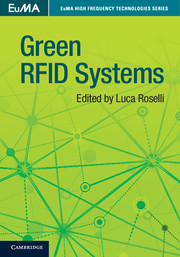Book contents
- Frontmatter
- Contents
- List of contributors
- Introduction
- 1 Context analysis
- 2 RFID background
- 3 Energy scavenging and storage for RFID systems
- 4 Technologies for RFID sensors and sensor tags
- 5 Unconventional RFID systems
- 6 Integrating tiny RFID- and NFC-based sensors with the Internet
- 7 Materials for substrates
- 8 Organic conductors and semiconductors: recent achievements and modeling
- 9 RFID enabling new solutions
- 10 Energy-efficient off-body communication using textile antennas
- Index
- References
6 - Integrating tiny RFID- and NFC-based sensors with the Internet
Published online by Cambridge University Press: 05 October 2014
- Frontmatter
- Contents
- List of contributors
- Introduction
- 1 Context analysis
- 2 RFID background
- 3 Energy scavenging and storage for RFID systems
- 4 Technologies for RFID sensors and sensor tags
- 5 Unconventional RFID systems
- 6 Integrating tiny RFID- and NFC-based sensors with the Internet
- 7 Materials for substrates
- 8 Organic conductors and semiconductors: recent achievements and modeling
- 9 RFID enabling new solutions
- 10 Energy-efficient off-body communication using textile antennas
- Index
- References
Summary
Introduction
In the upcoming era of ubiquitous cognition, the capability of gathering, processing, and presenting vast amounts of data captured by spatially distributed sensors in an efficient and low-cost way is as essential as ever. Although a plethora of ultra-low cost but yet powerful and physically small sensors have been demonstrated, only a few of these research efforts have managed to integrate these sensing modules with massive wireless sensor network (WSN) platforms: a sine-qua-non step.
The necessity of deploying WSN capabilities in sensing systems is highlighted by: (i) the increased physical range and the ability to overcome non-line-of-sight and path loss effects through multi-hopping; (ii) the enhanced reliability due to multipath communication even if some intermediate WSN nodes on the path toward the destination or a gateway fail; and (iii) the decreased power consumption of the radio transmission with multi-hopping, since it is more power efficient to relay packets over lower-strength shorter links than transmitting high strength signals over fewer long single-hop wireless links [1].
Toward that goal, demonstration of the prototypes presented in this chapter that realize real-time and distributed remote sensing within the scope of different applications serves as a proof of concept; it is possible to deploy WSN nodes in-between sensors and internet gateways. As a result of this approach, the primary task of the WSN nodes is not as data generators, as this is almost exclusively carried out by the sensors. Instead, the WSN nodes here serve simply as data routers that relay the sensed information through wireless multi-hop links to one or multiple gateways. It is important to note that the aforementioned prototyped wireless sensors cover the “last mile,” or more precisely the last wireless hop the length of which can range from a couple of meters to a few hundreds of meters.
- Type
- Chapter
- Information
- Green RFID Systems , pp. 152 - 175Publisher: Cambridge University PressPrint publication year: 2014
References
- 1
- Cited by

